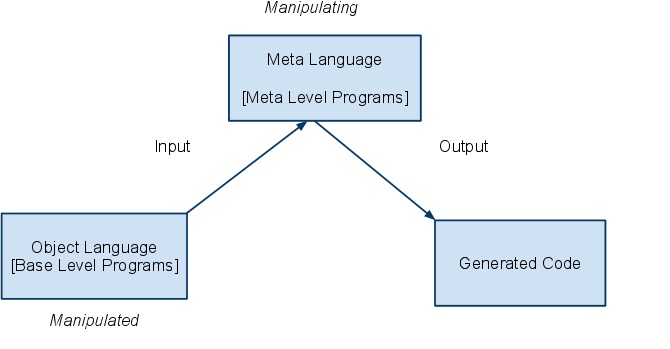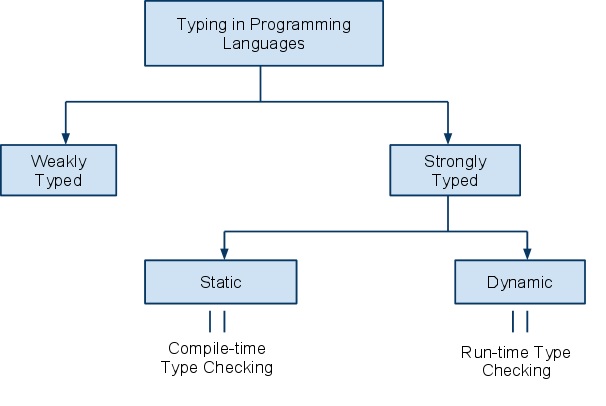CSC/ECE 517 Fall 2010/ch2 S24 rm
"I'd rather write programs that write programs than write programs" - Richard Sites
Introduction
Most metaprogramming is done in dynamic languages, like Ruby. Achieving metaprogramming in static languages directly, becomes complex due to its inherent nature of compile time abstraction verification. However, there are tools and packages for support of metaprogramming in statically typed languages, such as Java that can be leveraged to achieve metaprogramming features.
Metaprogramming
Metaprogramming is a programming technique of writing computer programs that write or manipulate other programs or themselves. In other words, it is a programming technique of writing programs with a higher level of abstraction to make it appear as generative programming.
Metaprogramming involves two kinds of languages. The meta-language is the language in which meta-programs, which construct or manipulate other programs, are written. The object-language is the language of programs being manipulated. This makes them ‘meta level programs’ whose problem domain are other ‘base level programs’.[1]
The ability of a programming language to be its own metalanguage is called reflection or reflexivity.
Simple example of a metaprogram: Let us consider a totally fabricated example for our understanding at very high level. Suppose we need to write a C program that printed the following 500 lines of text with a restriction that the program could not use any kind of loop or goto instruction.
Output expected:
1 Mississippi 2 Mississippi 3 Mississippi 4 Mississippi ... 499 Mississippi 500 Mississippi
In C this would be then coded as:
#include <stdio.h>
int main(void) {
printf("1 Mississippi\n");
printf("2 Mississippi\n");
-
-
-
printf("499 Mississippi\n");
printf("500 Mississippi\n");
return 0;
}
With the power of a metaprogramming language we can write another program that writes this program automatically.
Ruby code:
File.open('mississippi.c', 'w') do |output|
output.puts '#include <stdio.h>'
output.puts 'int main(void) {'
1.upto(500) do |i|
output.puts " printf(\"#{i} " +
"Mississippi\\n\");"
end
output.puts ' return 0;'
output.puts '}'
end
This code creates a file called mississippi.c with the expected 500+ lines of C source code.Here, mississippi.c is the generated code and ruby code is the metaprogram.
Applications of Metaprogramming
Metaprogramming is an attractive technique needed when one needs to alter the behavior of a program at run time. Due to its generative nature, it has numerous applications in program development. It can achieve program development without rewriting boiler-plate code all the time, ensuring efficiency, increasing modularity and minimizing inconsistent implementation errors. Program generators and program analyzers are the two main categories of meta programs. Metaprograms can be compilers, interpreters, type checkers etc. Some commonly used applications include using a program that outputs source code to -
- generate sine/cosine/whatever lookup tables
- to extract a source-form representation of a binary file
- to compile your bitmaps into fast display routines
- to extract documentation, initialization/finalization code, description tables, as well as normal code from the same source files
- to have customized assembly code, generated from a perl/shell/scheme script that does arbitrary processing
- to propagate data defined at one point only into several cross-referencing tables and code chunks. [33]
In many cases, this allows programmers to get more done in the same amount of time as they would take to write all the code manually, or it gives programs greater flexibility to efficiently handle new situations without recompilation. [1]
Typing in Programming Languages
Earlier programming languages [e.g. Assembly] were written such that each machine level function was reflected in the program code. With advancement in programming languages a certain level of abstraction was reached wherein lower level details were abstracted with one functional unit of work and represented by fewer lines of code e.g. primitive variables are represented with higher level abstract classes. With this abstraction arose a need for checking the validity of operations that could be performed with these abstractions in place.
Typing in programming languages is property of operations and variables in the language that ensure that certain kinds of values that are invalid are not used in operations with each other. Errors related to these are known as type errors. Type checking is the process of verifying and enforcing the constraints of types. Compile time type checking also known as static type checking. Run time type checking is known as dynamic type checking. If a language specification requires its typing rules strongly (i.e., more or less allowing only those automatic type conversions which do not lose information), one can refer to the process as strongly typed, if not, as weakly typed.[8] The above classification can be represented as -
Statically Typed Programming Languages
Statically typed languages ensure that a fixed type is assigned by the programmer to every variable and parameter. Thus, every expression type can be deduced and type checked during compilation. Static languages try to fix most errors during compile time and strive to minimize failures during run time. Due to this there are many type constraints on the programmer while coding. At run time, the program uses the classes that it has been given and in this way statically typed languages make distinctions between what happens at compile time and what happens at run time. Examples of statically typed languages are C, C++, Java, C#.
Dynamically Typed Programming Languages
In dynamically typed languages, the variables and parameters do not have a designated type and may take different values at different times. In all the operations, the operands must be type checked at runtime just before performing the operation. Dynamically typed languages don’t need to make a distinction between classes created at compile time and classes provided. It is possible to define classes at run time and in fact, classes are always defined at run time. These eliminate many developer constraints by avoiding the need of book keeping, declarations etc. Due to this flexibility these languages make an ideal candidate for prototyping and are widely used in agile development environments. However, dynamic languages are known to have performance issues. Static languages have code optimization features at compile time, but dynamic languages allow runtime code optimizations only. [7] In dynamically typed languages, the interpreter deduces type and type conversions, this makes development time faster, but it also can provoke runtime failures. These runtime failures are caught early on during compile time for statically typed languages. Examples of dynamically typed languages include Perl, Python, JavaScript, PHP, Ruby, Groovy.
Metaprogramming in statically typed languages
In safety languages [syntactically verbose], metaprogramming is not a standard feature, it can however be achieved. Also, static typing in meta-programs has a number of advantages. In addition to guaranteeing that the meta-program encounters no type-errors while manipulating object-programs, a statically typed metaprogramming language can also guarantee that any of the object-programs generated by the meta-program are also type-correct. A disadvantage of these type system is that (in case of meta-programming languages with weaker type systems) they sometime may be too restrictive in object-programs that the programmer is allowed to construct.

